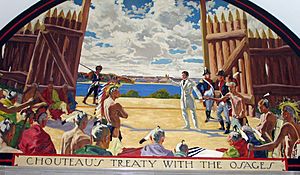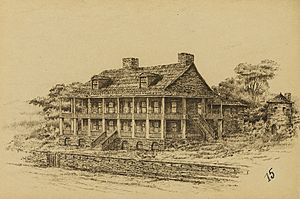Jean-Pierre Chouteau facts for kids
Quick facts for kids
Jean-Pierre Chouteau
|
|
|---|---|
 |
|
| Born | 10 October 1758 |
| Died | 10 July 1849 (aged 90) St. Louis County, Missouri, USA
|
Jean-Pierre Chouteau (born October 10, 1758 – died July 10, 1849) was an important figure in early American history. He was a French Creole fur trader, a merchant (someone who buys and sells goods), and a politician. He also owned enslaved people.
Chouteau was one of the first people to settle in St. Louis, moving there from New Orleans. He became one of the most important citizens in the city. His family played a big role in starting the fur trade in St. Louis, which helped the city become wealthy.
In 1975, he was honored by being added to the Hall of Great Westerners at the National Cowboy & Western Heritage Museum in Oklahoma City.
Contents
Early Life of Pierre Chouteau
Jean-Pierre Chouteau was often called Pierre. His mother was Marie-Therese Bourgeois Chouteau. His father was Pierre de Laclède de Liguest from France. Pierre was born in New Orleans when it was still controlled by France. He had three younger sisters.
Chouteau Family and Marriages
Jean-Pierre Chouteau married Pélagie Kiercereau on July 26, 1783, in St. Louis. They had four children together:
- Auguste P. Chouteau (1786–1838): He graduated from West Point and became a fur trader.
- Pierre Chouteau, Jr. (1789–1865): He started fur trading posts along the Upper Missouri River. These included Fort Pierre, South Dakota and posts in Chouteau County, Montana.
- Pélagie Chouteau (1790–after 1824): She married Bartholomew Berthold, a fur trader who worked with the Chouteau family. Fort Berthold was named after him.
- Paul Liguest Chouteau (1792–1851): He married Constance Chauvet-Dubreuil in St. Louis.
After Pélagie died, Jean-Pierre Chouteau married Brigitte Saucier on February 17, 1794, in St. Louis. They had five children, though one died when they were very young.
- François G. Chouteau (1797–1838): He was the first official European settler and founder of Kansas City, Missouri.
- Cyprien Chouteau (1802–1879): He worked for the Chouteau-Sarpy Fur Company in Kansas City.
- Pharamond Chouteau (1806–1831): He died at age 24.
- Frederick Chouteau (1809–1891): He was a fur trader and broker in Westport, Missouri. He married four times.
Chouteau's Fur Trade Business
Jean-Pierre and his half-brother Auguste Chouteau were known as "river barons." They were very good at adapting to political changes. For example, St. Louis went from being under Spanish rule to becoming part of the United States after the Louisiana Purchase in 1803. The brothers kept building strong relationships with different groups.
Trading with the Osage Nation
The Chouteau family began trading furs with the Osage Indians as early as the 1760s. Jean-Pierre Chouteau spent a lot of time with the Osage people. He learned their language, culture, and customs. In 1796, he set up a trading post in their territory. This post was at the meeting point of the Neosho River and Saline Creek. It became the first permanent European settlement in what is now Salina, Oklahoma. In the early 1800s, the trade between the Chouteau family and the Osage made up half of all Native American goods traded in St. Louis.
On March 19, 1799, Chouteau bought a large area of land from the Osage. This land is now known as Chouteau Springs, Missouri.

Becoming a US Agent
On July 14, 1804, President Thomas Jefferson chose Chouteau to be the US Agent for Indian Affairs west of the Mississippi River. This was a big step for Chouteau. It gave him access to important government officials. He also took his responsibilities seriously.
After becoming a US agent, Chouteau helped start the Missouri Fur Company in St. Louis in 1804. He did this with Manuel Lisa, another trader. Chouteau put a lot of effort into his company's fur trading. He worked with other family members and became one of the richest people in St. Louis. He kept a lot of political power even after the United States bought Louisiana.
Treaty of Fort Clark
Chouteau was a negotiator for the Treaty of Fort Clark, also called the Osage Treaty of 1808. He convinced the Osage to sell large parts of their land in what is now Missouri and Arkansas. In return, they received yearly payments (called annuities) from the US government.
The Chouteau brothers also stayed connected with Spanish officials further west. In 1817, the Spanish gave Pierre Chouteau a special license. This allowed him to be the only one who could trade with the Osage in their region, west of US lands. His fur trading business continued to do very well.
Political Influence
Chouteau was elected to the St. Louis Board of Trustees and became its first chairman. This shows how influential he was. He was chosen to serve on half of the twelve boards between 1810 and 1822. He was also appointed as a justice of the peace, which is a local judge.
Freedom Suits and Slavery
St. Louis was a place where many enslaved people filed "freedom suits." These were lawsuits where enslaved people tried to gain their freedom. They often argued that they were being held illegally.
In 1826, Pierre Chouteau was sued by an enslaved woman named Marguerite Scypion. Marguerite had filed the first freedom suit in St. Louis in 1805 against a previous owner. Marguerite was of African and Natchez Native American descent. Her grandmother was Natchez. Spanish officials had made Native American slavery illegal in 1769. This was after Spain took control of the land from France. However, Native American slavery had been common in Missouri under French rule.
Marguerite's children argued that because their grandmother was Natchez Indian, their mother should have been freed in 1769. This would mean they should have been born free. In those days, the legal status of children was decided by their mother's status. So, if a mother was enslaved, her child was also born into slavery. Even though Marguerite's daughters and their descendants won their case, a higher court later overturned the decision. But for 30 years, Marguerite's family kept fighting for their freedom.
In late 1824, the Missouri General Assembly passed a law. This law created a way for enslaved people to sue for their freedom and have some protections during the process. In 1825, Marguerite started her case again against Pierre Chouteau, Sr., who was her owner at the time. Her sisters also sued their owners. All these cases were combined under Marguerite's name.
The first court decisions and appeals to the Missouri Supreme Court went against the Scypion family. However, the case was reviewed again in 1834, and a new trial was ordered. The lawyers for the enslaved people asked to move the trial to a different county. They felt that the Chouteau family was too powerful in St. Louis. The court agreed. The trial was moved first to St. Charles County and then to Jefferson County. The trial finally began on November 8, 1836. The jury decided unanimously in favor of Marguerite and the other Scypion descendants. This decision was upheld by the US Supreme Court in 1838. This important case is seen as the official end of Native American slavery in Missouri.
Jean-Pierre Chouteau was the head of a large and influential family. He died in St. Louis at the age of 90.


